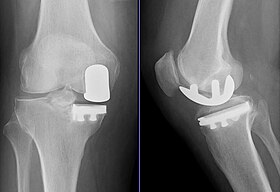Unicompartmental knee arthroplasty
| Unicompartmental knee arthroplasty | |
|---|---|

Radiographs of a knee arthroplasty of the medial compartment
|
|
| ICD-9-CM | 81.54 |
Unicompartmental knee arthroplasty is a surgical procedure used to relieve arthritis in one of the knee compartments in which the damaged parts of the knee are replaced. UKA surgery may reduce post-operative pain and have a shorter recovery period than a total knee replacements. Also, UKA may have a smaller incision because the implants may be smaller.
In the United States, this procedure constitutes approximately 8% of knee arthroplasty.
In the early 1950s, Duncan C. McKeever theorized that osteoarthritis could be isolated to only one compartment of the knee joint, and that replacement of the entire knee might not be necessary if only one knee compartment was affected. The UKA concept was designed to cause less trauma or damage than traditional total knee replacement by removing less bone and trying to maintain most of the patient’s bone and anatomy. Also, the concept was designed to use smaller implants and thereby keep most of the patient’s bone; this can help patients return to normal function faster.
Initially, UKAs were not always successful, because the implants were poorly designed, patients weren't thoroughly screened for suitability, and optimal surgical techniques were not developed. Recent advancements have been made to improve the design of the implants. Also, choosing the best-suited patients was emphasized to ensure that surgeons followed the indications and contraindications for partial replacement. Proper patient selection, following the indications/contraindications, and performing the surgery well are key factors for the success of UKA.
Currently, UKA is often referred to as "partial knee replacement." In reality there is nothing "partial" about this replacement. It is a complete replacement of the "part" of the knee that is arthritic. Patients who have arthritis restricted to only one part of the knee and have no reason to not have this surgery ("contraindications" is the medical term for a reason not to have a particular procedure) could consider this option.
UKA may be suitable for patients with moderate joint disease caused by painful osteoarthritis or traumatic injury, a history of unsuccessful surgical procedures or poor bone density that precludes other types of knee surgery. Patients that may not be eligible for a UKA include patients that have an active or suspected infection in or about the knee joint, may have a known sensitivity to device materials, have bone infections or disease that result in an inability to support or fixate the new implant to the bone, have inflammatory arthritis, have major deformities that can affect the knee mechanical axis, have neuromuscular disorders that may compromise motor control and/or stability, have any mental neuromuscular disorder, patients who are not skeletally mature, are obese, have lost a severe amount of bone from the shin (tibia) or have severe tibial deformities, have recurring subluxation of the knee joint, have untreated damage to the knee cap and thigh bone joint (patellofemoral joint), have untreated damage to the opposite compartment or the same side of the knee not being replaced by a device, and/or have instability of the knee ligaments such that the postoperative stability the UKA would be compromised.
...
Wikipedia
